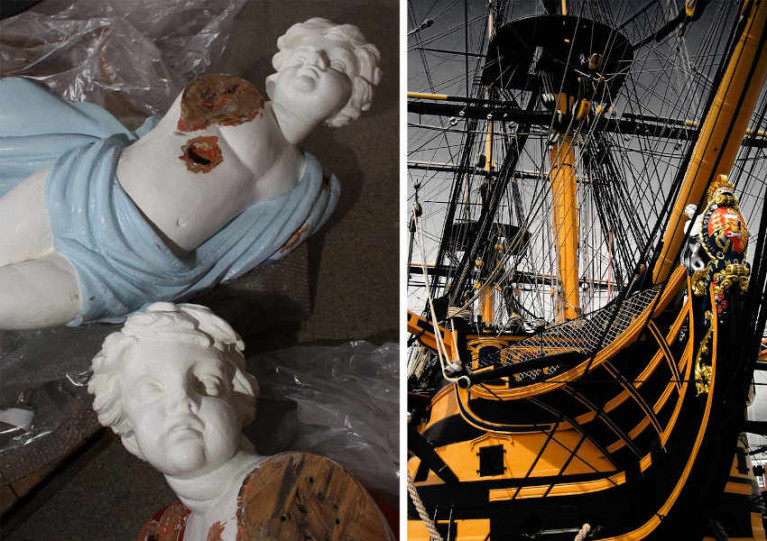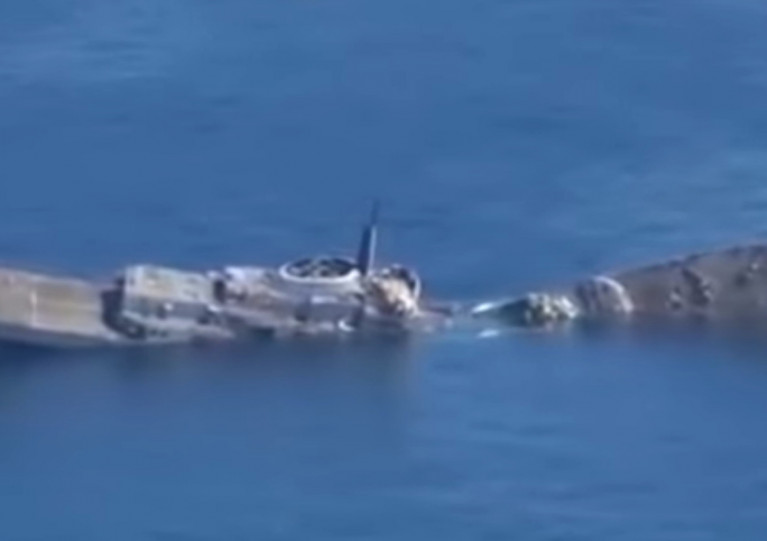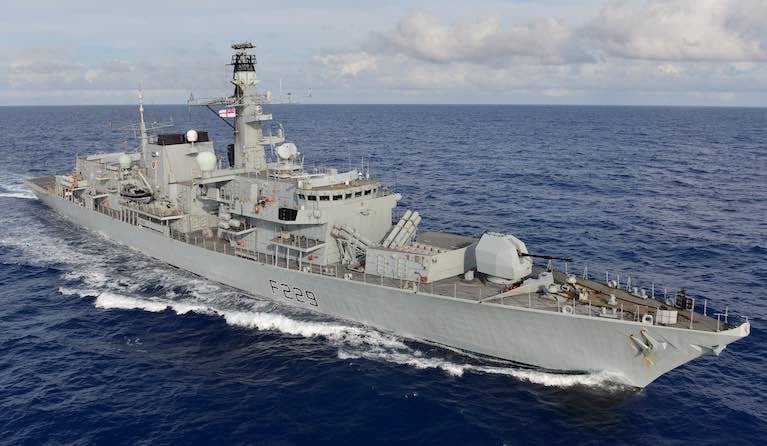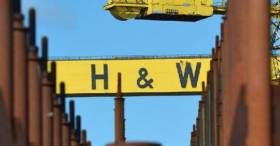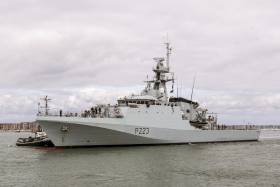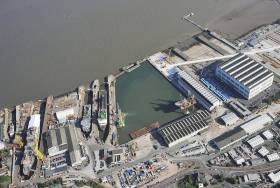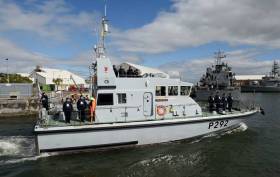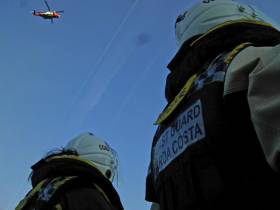Displaying items by tag: Royal Navy
Royal Navy Blames Propeller Issues for Flagship’s Withdrawal From Historic NATO Drill
The UK’s Royal Navy has withdrawn its fleet flagship from a historic NATO exercise on Norway’s Arctic coast over what it says are issues with the vessel’s propeller.
According to Marine Industry News, the HMS Queen Elizabeth had been due to sail from Portsmouth on Sunday evening (4 February) until routine checks identified an issue with a coupling on the vessel’s starboard propeller shaft.
The £3.5bn, 65,000-ton aircraft carrier — which has parts constructed in the same shipyard that built the Naval Service’s LÉ George Bernard Shaw — will be replaced by sister ship HMS Prince of Wales in exercise Steadfast Defender 2024.
The Prince of Wales has had its own share of propeller issues, previously breaking down shortly after setting out for the United States on deployment in August 2022.
Steadfast Defender 2024 is NATO’s largest exercise since the end of the Cold War, involving some 90,000 military personnel from all NATO members and Sweden.
Marine Industry News has more on the story HERE.
Royal Navy Admits Presence in Area Linked to Whale Strandings in 2018
The UK’s Royal Navy has admitted that it was conducting operations in an area linked to the mass stranding of deep-diving whales in Ireland and Scotland three years ago, according to a report in The Times.
Record numbers of beaked whales stranded along Ireland’s North West between Galway and Donegal throughout August 2018, with a similar number found in Scotland. Records were also made in Iceland and the Faroe Islands.
The matter became the focus of a joint investigation by the Department of Foreign Affairs and UK authorities, which later traced the whales’ origin to the Porcupine Bank some 200km off the West Coast.
Use of sonar has been blamed by some experts for previous strandings of deep-diving species like the Cuvier’s beaked whale.
While the Royal Navy is known to use sonar in its operations, unlike Ireland’s Naval Service, it issued a statement in August 2018 saying that there is “no evidence that the deaths of these marine mammals have been attributed to any Royal Navy sonar operations, trials or exercises”.
The Times has more on the story HERE. (Subscription required.)
Sawn-Up Replica of HMS Victory Figurehead Dates from Just Years After Battle of Trafalgar, Scientists Say
Scientists have discovered that a replica of the figurehead from the warship Admiral Nelson commanded in the Battle of Trafalgar dates from just years after the event.
Unfortunately, the 10-foot-tall sculpture was cut up by chainsaw into six pieces more than a decade ago under the mistaken belief it was a modern recreation, as the Independent reports.
Experts working with the National Museum of the Royal Navy, which took stewardship of all material related to HMS Victory from the UK’s Ministry of Defence in 2012, took another look at the destroyed sculpture two years ago.
And they discovered that it was actually made in 1815 as a replacement for the original that suffered damage during that key naval battle of the Napoleonic Wars in 1805.
Now its remnants are set to be displayed to the public for the first time alongside the surviving HMS Victory in Portsmouth, once pandemic restrictions allow.
The Independent has more on the story HERE.
Former Royal Navy Frigate Sunk In Live-Fire Exercise
A former Royal Navy frigate was sunk in spectacular fashion during a live-fire exercise off Pakistan, as Mail Online reports.
HMS Active was commissioned in 1977 and saw active duty in the Falklands War among other missions before being sold to Pakistan in 1994 and renamed the PNS Shah Jahan.
The Type 21 frigate went out in a hail of firepower earlier this month as one of a number of targets used in a drill by the Pakistan Navy in the North Arabian Sea.
Mail Online has more on the story HERE.
Government Drops any Inquiry into Encounter Between Fishing Vessel & Royal Navy Frigate
The Government has opted not to pursue an incident where a British navy ship instructed an Irish fishing vessel to leave grounds where it was working some 60 miles off the Donegal coast.
The 32-metre fishing vessel Marlíona, registered in Greencastle, Co Donegal, was hailed by the British navy ship HMS Lancaster on July 21st last and asked to leave the area, even though it is well within the Irish exclusive economic zone (EEZ).
The Department of Foreign Affairs said it was investigating the incident, which had been referred to the Sea Fisheries Protection Authority (SFPA) by the Killybegs Fishermen’s Organisation (KFO).
However, the department has subsequently said the location was “not within Ireland’s territorial sea and did not, therefore, infringe our sovereignty”.
“In general, it is not unusual for naval ships to ask other vessels in the vicinity to move away from an exercise location for safety reasons,” the department said.
A British navy spokesperson said that “courteous and professional exchanges between the fishing vessel and frigate operating within the designated exercise area enabled this lawful exercise to continue and conclude safely”.
“The safety of all mariners is taken extremely seriously by the Royal Navy. At no time was there a risk to safety to either the fishing vessel or submarine,” the British navy spokesperson said.
The British Directorate of Defence Communications said the ship “operated throughout in accordance with the UN Convention of the Law of Sea, having due regard for other vessels operating in the area”.
However, KFO chief executive Sean O’Donoghue has said there is now a case for the Government to state that the Irish EEZ should be protected from military training exercises by submarines on environmental grounds.
The Celtic League non-governmental organisation based in the Isle of Man has written to the Taoiseach Micheál Martin on the issue.
It says that the dangers posed to fishing vessels by the activity of submarines “of all powers” were “highlighted graphically” when the Irish MFV Sharelga (italics) was sunk by HMS Porpoise” off the Co Louth coast in April, 1982.
“No lives were lost on that occasion however, unfortunately, that was not the case sometime later when the Scottish MFV Antares was sunk - all crewmen died,” the letter by league assistant general secretary Bernard Moffatt states.
He refers to the recent towing of Co Down MFV Karen by a British submarine, and says an inquest in Cornwall has “still to determine the fate of the crew members of the Breton trawler Bugaled Breizh lost of the Lizard during a NATO exercise”.
Mr Moffatt reminds Mr Martin that a campaign via an Irish government initiative led to the adoption of two International Maritime Organisation (IMO) resolutions.
Mr Moffatt says one of these two resolutions, A709 (17), places an onus on the British navy to move the exercise or cease it, rather than request the fishing vessel to give way.
Asked to comment on the issue, the Department of Agriculture, Food and Marine said that the issue was “not relevant” to it and referred to the Department of Foreign Affairs.
The Department of Foreign Affairs said the issue was one for the Department of Agriculture, Food and Marine.
Contract from Royal Navy Could be Vital Lifeline for Harland & Wolff Shipyard
Shipyard Harland & Wolff has taken a step closer to survival with confirmation that the consortium to which it belongs has been awarded a £1.25bn contract to build new warships.
As the News Letter reports, East Belfast MP Gavin Robinson described the decision – giving the green light for the Babcock-led consortium to build the Type 31e Royal Navy frigates – as a “boon” for the Belfast shipyard and said it was “hugely encouraging”.
The news come as Belfast Harbour launched a strategic plan to invest £254 million in new infrastructure which will help generate 7,000 new jobs.
The development at Harland & Wolff is a vital lifeline for a company that went into administration just over a month ago.
For more click here on the story
Following the Rockall fishery dispute that grabbed the headlines last week, the UK's newest Fishery Patrol Vessel (FPV) completed a delivery voyage from Scotland to its homeport of Portsmouth today, writes Jehan Ashmore.
HMS Medway arrived on Solent waters this morning. The newbuild is the second of five new British Royal Navy Batch 2 River-class offshore patrol vessel (OPV) currently under construction on the Clyde at BAE Systems Scotstoun yard.
The final Batch 2 river class OPV HMS Spey was on Friday taken out of the shipyard's Block Outfit Hall and positioned onto the hard stand ready to be loaded onto the launch barge.
BAE's shipyard is located upriver of the striking multi-award winning Riverside Museum in Glasgow where Afloat visited the iconic building designed by the Iranian born architect, the late Zaha Hadid.
As for the design of the HMS Medway and its future function, according to the Royal Navy they they will not use the Batch 2 class primarily for safeguarding fishing stocks in home waters but ‘forward deploy’ around the world. In addition to fishery duties, the class are designed to carry out counter-terrorism and anti-smuggling requirements in order to safeguard the UK's borders.
The new class each of 2000 tonnes will according to Naval Technology are to replace the Royal Navy’s current River-class patrol ships, including HMS Clyde, Severn, Tyne and Mersey. See report of Dublin Port call of the Liverpool based OPV and related role in the UK Government's Brexit contingency fund plan.
Leadship of the class is HMS Forth which like the rest of the class could find themselves on patrol in the Atlantic, the Caribbean, Mediterranean or the Pacific rim operating from Singapore.
In December HMS Medway took its first sea trials along the Firth of Clyde and from where Afloat last Friday had traced the OPV back to the Faslane Naval Base on Gare Loch having departed the previous day. Faslane is the homeport of the Royal Navy's Trident class nuclear powered submarines.
The course set by HMS Medway also revealed further sea trails exercises that took place in the southern waters of the Firth of Cyde. This involved an area between Ardrossan in Ayrshire and Ailsa Craig, an impressive rocky islet.
On the following day (Friday) HMS Medway was tracked by Afloat when its reached the centre of the St. Georges Channel. It is in these waters where the temporary Rosslare-Fishguard ferry Stena Nordica (deputing for Stena Europe) had already proceeded beyond mid-channel during a routine morning sailing to the Pembrokeshire port in south-west Wales.
According to AIS system, HMS Medway achieved a speed of 24.9 knots while in relatively close quarters of an Irish flagged dry-cargoship the Arklow Cliff. At just three metres shorter in length compared to the 90m naval newbuild, the 2,999grt cargoship had too set a southerly course.
Arklow Cliff Afloat featured its launch just two years ago and on this occasion as an operational ship was tracked underway while making a more sedate speed of 11.9 knots. By coincidence Arklow Cliff was bound for the River Medway where the town and Port of Rochester is located about 30 miles east of London.
Arklow Cliff likewise of HMS Medway had departed its last port last Thursday, but from Warrenpoint in Co. Down. The short-sea trader arrived in the north Kent port yesterday having sailed along the Thames Estuary from where on the southern shore the cargoship entered the Medway to approach Rochester.
#Ports&Shipping- Three shipbuilding teams in the UK, according to a Ministry of Defence statement, have been awarded multi-million-pound contracts to push ahead with plans to build five new Type 31e warships for the Royal Navy.
The announcement from the British Defence Minister Stuart Andrew took place in Portsmouth Naval Base last week on board HMS Diamond, (see sister, Defender's recent Irish visit) which returned from the Mediterranean.
The Minister revealed that teams led by BAE Systems, (see Merseyside yard Cammell Laird) Babcock and Atlas Elektronik UK have been shortlisted for the competition to build the five frigates for £1.25 billion.
Each group has been awarded a contract worth up to £5 million to fund the next stage of their plans, with the preferred bidder for the design and manufacture of the ships due to be announced by the end of next year. The MOD want the first ship delivered in 2023.
Speaking in Portsmouth, Defence Minister Stuart Andrew said: “This is the first frigate competition the UK has run in a generation, and we are funding three shipbuilding teams with extremely exciting concepts to continue developing their plans. Next year we will announce the winning bidder, and one of these designs will go on to bolster our future fleet with five new ships, creating UK jobs and ensuring our Royal Navy maintains a truly global presence in an increasingly uncertain world.”
The awarding of the contracts is a key milestone in the National Shipbuilding Strategy, which was launched in September 2017. The Strategy met the challenges set by an independent report written by Sir John Parker, a figure with a wealth of leadership and boardroom experience in shipbuilding, and was underpinned by the commitment to build the new Type 31e ships.
The bold Type 31e programme will move through procurement at an unprecedented pace: the vessel will commence production within 3 years of the launch of the programme, far quicker than similar programmes of this type.
The ships will make up the next generation of the Royal Navy fleet, along with eight Type 26 warships which will start being delivered from the mid-2020s. The names of all eight Type 26 frigates have now been announced, and the Defence Secretary Gavin Williamson has also outlined that they will be homed in Devonport.
The decision on where the Type 31e frigates will be based is still to be made.
University Challenge As UK’s Royal Navy Boat Squadron On Tour
#NavalVisits - At this stage of the UK’s Royal Navy University Boat Squadron tour the last visit was to Kinsale Harbour and followed calls to Cork, Waterford and Dublin, where the flotilla is to return for the Easter Weekend, writes Jehan Ashmore.
Afloat has been monitoring movements of the naval flotilla of Archer P2000 class inshore patrol boats that visited Dublin Port last week at the Poolbeg Yacht & Boat Club Marina. The patrol trio comprise of HMS Biter, Charger and Persuer which are part of the First Patrol Boat Squadron, whose primary role is to support the University Royal Naval Units (URNU).
The White Ensign flagged visitors had berthed in Kinsale Yacht Club Marina where they arrived this week until departing last night. Also in port was and remains today the Musketier, a Manx flagged Peel registered cargoship that is operated from an East Cowes, Isle of Wight based company, Faversham Ships.
Prior to the call to Kinsale Harbour, a courtesy call was paid to the Irish Naval Service base in Cork Harbour where the P2000's berthed within the naval dock basin. Upon arrival, four Naval Service patrol vessels were berthed. A pair of Babcock built OPV’s from their shipyard in Appledore, Devon, flagship HPV LÉ Eithne built locally in Rushbrooke and CPV LÉ Orla, the former RN HMS Swift launched in Aberdeen and which formed part of the Hong Kong Patrol Squadron.
Since Sunday, members of the URNU travelled from Dublin to Waterford and this was followed in Cork Harbour where they met with Commodore Michael Malone Flag Officer Commanding Naval Service. Another recent naval visitor albeit to Cork City quays was the Belgium Navy’s BNS Castor, a patrol vessel where relationships with the city and nation were strengthened.
In total 14 craft from the RN’s Archer P2000 class are assigned to the UNRUs though they also contribute to a wide range of fleet tasking. A RN Lieutenant commands each of the URNUs and is responsible for 51 undergraduates during their time in the Unit. The university squadron is not a recruiting organisation and membership of the URNU carries no obligation to join the Royal Navy on graduation.
Equally to the same number of P2000 craft, 14 units of the URNU are located around the UK offering opportunities to 700 undergraduates from the country’s leading universities in England, Scotland and Wales. An example been HMS Charger which has been the URNU for Liverpool University since 1990. The 54 tonnes craft is based at Brunswick Dock on the site of the new Royal Naval Headquarters on Merseyside.
The URNU aims to broaden a naval understanding and develop undergraduates who show potential through maritime experience and exposure to the values and ethos of the RN.
In addition they have opportunities to take part in sporting events, adventurous training activities and gain a CMI qualification all within a vibrant and friendly social scene.
#Coastguard - The Irish Coast Guard has airlifted a sailor with leg injuries from a Royal Navy submarine off the West Coast of Ireland, as The Irish Times reports.
Sligo’s Rescue 118 helicopter was dispatched to the scene some 277km west of Achill Island yesterday morning (Tuesday 9 May), with top cover provided by the Shannon-based Rescue 115.
The submarine crewman was flown to Sligo University Hospital for treatment.
An earier version of this story erroneously reported the submarine crewman as Irish but his nationality is uncomfirmed.



























